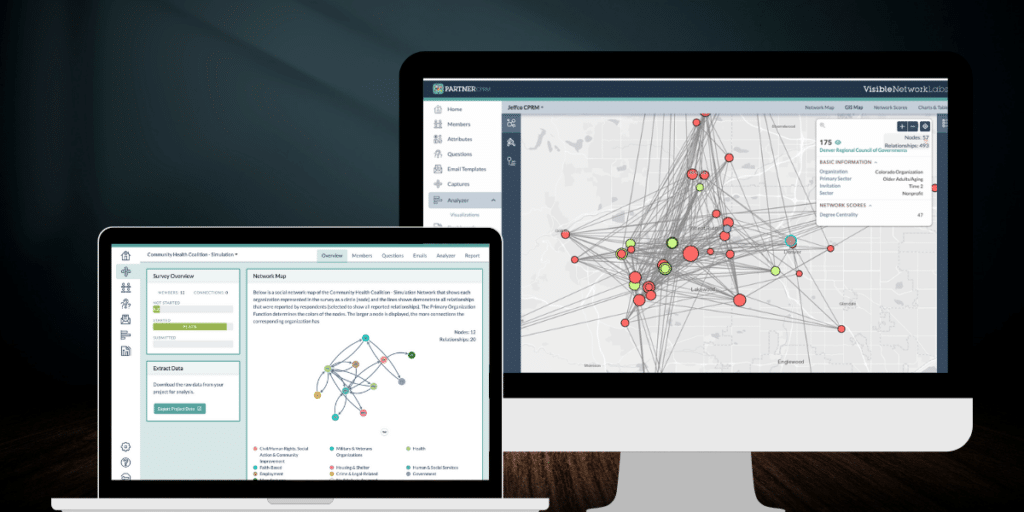Understanding the strength of relationships within a network is crucial for anyone involved in community partnerships, collaborative projects, or organizational networks. Whether you are working in healthcare, education, environmental advocacy, or any other field, measuring the strength of these relationships can inform your strategies, enhance collaboration, and improve outcomes. Social Network Analysis (SNA) provides a robust framework for this purpose.
In this article, we will explore various metrics and approaches to measure relationship strength, discuss best practices, and provide practical examples to guide your work.
Table of Contents
Defining Relationship Strength
There is no single way to define the ‘strength’ of a relationship. Different conceptualizations of strength will provide different kinds of insights, depending on your context and situation. It’s critical to choose the right measures and define “strength” appropriately given your research questions and objectives.
Here are five different ways you can define and measure relationship strength using SNA:

1. Frequency of Interaction
Frequency of interaction refers to how often partners communicate or collaborate within a specified timeframe.
- Metric: This can be measured by the number of interactions (meetings, emails, phone calls) over a week, month, or year.
- Insights: High-frequency interactions often indicate active engagement and a robust partnership. For example, partners who meet weekly to discuss projects and share updates demonstrate a strong commitment to collaboration.
2. Duration of Relationship
Duration refers to the length of time that partners have been working together.
- Metric: Measured in years or months, this metric tracks the longevity of the partnership.
- Insights: Long-standing relationships typically reflect trust and reliability. For instance, a partnership that has lasted over a decade likely indicates deep mutual understanding and commitment.
3. Diversity of Interaction
Diversity of interaction assesses the variety of contexts or projects in which partners collaborate.
- Metric: This can be quantified by the number of different projects, initiatives, or areas of work involving both partners.
- Insights: Diverse interactions signify a versatile and resilient partnership. Partners involved in various projects (e.g., healthcare initiatives, educational programs, community events) are better equipped to adapt to changes and challenges.
4. Intensity of Interaction
Intensity measures how “strong” a partnership is based on the level of formality and involvement in one another’s activities, from simple awareness of each other, to full integration of programs.
- Metric: This can be evaluated by the amount of resources invested in joint activities.
- Insights: High-intensity interactions suggest a highly committed and resource-intensive partnership. For example, partners who invest significant funds and effort into a joint initiative indicate a strong, high-stakes relationship.
5. Reciprocity
Reciprocity examines the balance of resource exchange and support between partners to determine whether both sides receive equal value.
- Metric: This can be assessed by the ratio of contributions to benefits received by each partner.
- Insights: Balanced reciprocity often leads to sustainable partnerships. If both partners equally share resources and benefits, the relationship is likely equitable and mutually beneficial.
6. Trust
Trust refers to the perception of partner’s reliability, openness to communication, and mission alignment in a partnership.
- Metric: This can be evaluated through SNA surveys, asking partners to rate their level of trust or sub-indidcators in the other party.
- Insights: High levels of trust often signify a strong, reliable partnership. For example, partners who rate their trust level highly are likely to feel secure in their collaboration and confident in the other party’s commitment to shared goals.

Best Practices for Measuring Relationship Strength
Through hundreds of SNA projects over the past decade, our team has developed some best practices for measuring the strength of relationships using social network analysis.
1. Align Metrics with Objectives
Choose metrics that align with your specific goals. For example, if you are assessing collaboration effectiveness, focus on frequency and intensity of interactions.
2. Use Mixed Methods
Combine quantitative SNA metrics with qualitative data (e.g., interviews, surveys) to gain a deeper understanding of relationship dynamics.
3. Contextual Relevance
Tailor your approach to the specific context and type of partnership. For instance, healthcare partnerships might prioritize different metrics than educational partnerships.
4. Dynamic Analysis
Conduct longitudinal studies to understand how relationships evolve over time. This helps identify patterns and critical turning points in partnerships.
5. Visualize Networks
Use network visualizations to identify key patterns and insights. Visual aids can help stakeholders understand complex relationships and interactions.
PARTNER CPRM: A Platform for Tracking Relationship Strength
While SNA is a powerful tool for measuring the strength of your relationships, it requires significant resources, knowledge, and time to implement on your own. That’s why our team created PARTNER CPRM, a community partner relationship management platform, using SNA and network science best practices.
PARTNER brings together data collection, analysis, mapping and reporting, and combines them with traditional relationship management tools common in many CRM systems, to provide a complete platform for managing relationships with partners across your community ecosystem. With our built-in trust and value scores, network visualization tools, and dozens of key network metrics, it has everything you need to measure, track and strengthen your relationships over time.

Seeing is Believing: Request a Demo!
Learn more about PARTNER and see it for yourself by requesting a live web demo with a network scientists from our team. We look forward to connecting!
Conclusion
Measuring the strength of relationships within a network is vital for understanding and enhancing collaboration. By using SNA metrics such as frequency, duration, diversity, intensity, reciprocity, and centrality, you can gain valuable insights into your community partnerships. Aligning these metrics with your objectives, using mixed methods, and considering the specific context of your partnerships will help you make informed decisions and improve outcomes.
Whether you are in healthcare, education, environmental advocacy, or any other field, these practices will guide you in building stronger, more effective networks.
Additional Resources
Looking for more information? Here are some additional websites, articles, and resources related to measuring relationship strength.
FAQ
Below are some common questions we get asked related to this topic. You can also leave a comment with additional questions and our team will get back to you with more information as soon as possible.
Q: How do you measure relationship strength?
A: Relationship strength can be measured through various metrics like frequency of communication, duration of the relationship, mutual benefits, trust levels, and reciprocal actions. In Social Network Analysis (SNA), relationship strength is often quantified by assessing the frequency and quality of interactions between partners.
Q: How do you measure working relationships?
A: Working relationships can be measured by examining factors such as collaboration efficiency, goal alignment, conflict resolution effectiveness, and the level of support provided to one another. Surveys and feedback tools are commonly used to gather quantitative and qualitative data from the involved parties.
Q: What is the statistical test for the strength of the relationship?
A: In SNA, the strength of relationships can be analyzed using correlation coefficients to examine the relationship between variables. Regression models may also be used to predict relationship outcomes based on interaction data. Advanced SNA metrics like centrality or density might also provide insights into the overall strength and structure of network relationships.
Q: How do you test the strength of your relationship?
A: Testing the strength of a relationship often involves qualitative assessments through surveys or interviews, where questions are focused on satisfaction, trust, and mutual understanding. Quantitatively, analyzing communication patterns, like the number of interactions and response times, can provide objective measures of relationship strength.
Q: What are common ways of defining relationship strength?
A: Relationship strength is commonly defined by the level of trust, the frequency and quality of interactions, and the perceived value of the relationship by each party. Additionally, the extent of shared resources and support indicates a strong, resilient relationship.
Q: What are some tools for measuring the strength of relationships?
A: Tools for measuring relationship strength include SNA software like PARTNER CPRM or Gephi, which help visualize and quantify network structures and relationships. Other tools like surveys (using platforms like SurveyMonkey or Google Forms) and CRM systems can track interaction history and analyze relationship trends over time.






